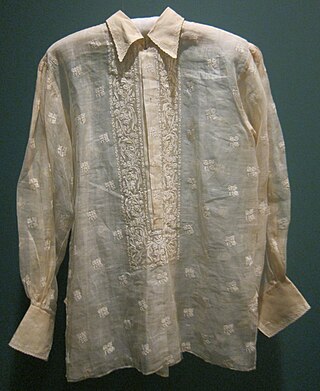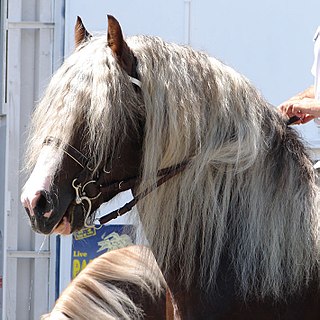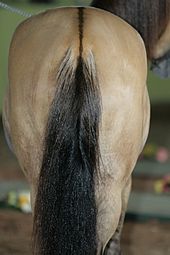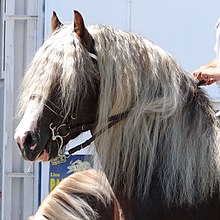
Textile is an umbrella term that includes various fiber-based materials, including fibers, yarns, filaments, threads, different fabric types, etc. At first, the word "textiles" only referred to woven fabrics. However, weaving is not the only manufacturing method, and many other methods were later developed to form textile structures based on their intended use. Knitting and non-woven are other popular types of fabric manufacturing. In the contemporary world, textiles satisfy the material needs for versatile applications, from simple daily clothing to bulletproof jackets, spacesuits, and doctor's gowns.

Linen is a textile made from the fibers of the flax plant.

Textile arts are arts and crafts that use plant, animal, or synthetic fibers to construct practical or decorative objects.
In music, a bow is a tensioned stick which has hair coated in rosin affixed to it. It is moved across some part of a musical instrument to cause vibration, which the instrument emits as sound. The vast majority of bows are used with string instruments, such as the violin, viola, cello, and bass, although some bows are used with musical saws and other bowed idiophones.

Upholstery is the work of providing furniture, especially seats, with padding, springs, webbing, and fabric or leather covers. The word also refers to the materials used to upholster something.

A mattress is a large, usually rectangular pad for supporting a lying person. It is designed to be used as a bed, or on a bed frame as part of a bed. Mattresses may consist of a quilted or similarly fastened case, usually of heavy cloth, containing materials such as hair, straw, cotton, foam rubber, or a framework of metal springs. Mattresses may also be filled with air or water.

Bedding, also called bedclothes or bed linen, is the materials laid above the mattress of a bed for hygiene, warmth, protection of the mattress, and decorative effect. Bedding is the removable and washable portion of a human sleeping environment. Multiple sets of bedding for each bed are often washed in rotation and/or changed seasonally to improve sleep comfort at varying room temperatures. Most standardized measurements for bedding are rectangular, but there are also some square-shaped sizes, which allows the user to put on bedding without having to consider its lengthwise orientation.

Flocking is the process of depositing many small fiber particles onto a surface. It can also refer to the texture produced by the process, or to any material used primarily for its flocked surface. Flocking of an article can be performed for the purpose of increasing its value. It can also be performed for functional reasons including insulation, slip-or-grip friction, retention of a liquid film, and low reflectivity.

The barong tagalog, more commonly known simply as barong, is an embroidered long-sleeved formal shirt for men and a national dress of the Philippines. Barong tagalog combines elements from both the precolonial native Filipino and colonial Spanish clothing styles. It is traditionally made with sheer textiles (nipis) woven from piña or abacá; although in modern times, cheaper materials like organza silk, ramie or polyester are also used.

Ticking is a type of cloth, traditionally a tightly-woven cotton or linen textile. It is traditionally used to cover tick mattresses and bed pillows. The tight weave makes it more durable and hinders the stuffing from poking through the fabric. To make it even tighter, ticking could be waxed, soaped, or starched. Tick materials designed to hold foam may be knit, or more porous. In English-speaking countries ticking commonly has a striped design, in muted colors such as brown, grey or blue, and occasionally red or yellow, against a plain, neutral background.

Haircloth is a stiff, unsupple fabric typically made from horsehair and/or from the wooly hair of a camel. Although horsehair generally refers to the hair of a horse's mane or tail, haircloth itself is sometimes called horsehair. Horse or camel hair woven into haircloth may be fashioned into clothing or upholstery.

On horses, the mane is the hair that grows from the top of the neck of a horse or other equine, reaching from the poll to the withers, and includes the forelock or foretop. It is thicker and coarser than the rest of the horse's coat, and naturally grows to roughly cover the neck. Heredity plays a role, giving some horses a longer, thicker mane, and others a shorter, thinner one.
The manufacture of textiles is one of the oldest of human technologies. To make textiles, the first requirement is a source of fiber from which a yarn can be made, primarily by spinning. The yarn is processed by knitting or weaving, which turns yarn into cloth. The machine used for weaving is the loom. For decoration, the process of colouring yarn or the finished material is dyeing. For more information of the various steps, see textile manufacturing.

Animal fibers are natural fibers that consist largely of certain proteins. Examples include silk, hair/fur and feathers. The animal fibers used most commonly both in the manufacturing world as well as by the hand spinners are wool from domestic sheep and silk. Also very popular are alpaca fiber and mohair from Angora goats. Unusual fibers such as Angora wool from rabbits and Chiengora from dogs also exist, but are rarely used for mass production.

Grosgrain is a type of fabric or ribbon defined by the fact that its weft is heavier than its warp, creating prominent transverse ribs. Grosgrain is a plain weave corded fabric, with heavier cords than poplin but lighter than faille, and is known for being a firm, close-woven, fine-corded fabric. Grosgrain has a dull appearance, with little luster in comparison to many fabric weaves, such as satin, often used for ribbons; however, it is comparatively very strong. Grosgrain fabric is most commonly available in black, but grosgrain ribbon comes in a large variety of colors and patterns. The ribbon is very similar to Petersham ribbon in its appearance, but it does not have the ability to follow the curves of a surface or edge the way that the latter does.

Horse grooming is hygienic care given to a horse, or a process by which the horse's physical appearance is enhanced for horse shows or other types of competition.

The Andean textile tradition once spanned from the Pre-Columbian to the Colonial era throughout the western coast of South America, but was mainly concentrated in was is now Peru. The arid desert conditions along the coast of Peru have allowed for the preservation of these dyed textiles, which can date to 6000 years old. Many of the surviving textile samples were from funerary bundles, however, these textiles also encompassed a variety of functions. These functions included the use of woven textiles for ceremonial clothing or cloth armor as well as knotted fibers for record-keeping. The textile arts were instrumental in political negotiations, and were used as diplomatic tools that were exchanged between groups. Textiles were also used to communicate wealth, social status, and regional affiliation with others. The cultural emphasis on the textile arts was often based on the believed spiritual and metaphysical qualities of the origins of materials used, as well as cosmological and symbolic messages within the visual appearance of the textiles. Traditionally, the thread used for textiles was spun from indigenous cotton plants, as well as alpaca and llama wool.

Primarily, nap is the raised (fuzzy) surface on certain kinds of cloth, such as velvet or moleskin. Nap can refer additionally to other surfaces that look like the surface of a napped cloth, such as the surface of a felt or beaver hat.

A tick mattress, bed tick or tick is a large bag made of strong, stiff, tightly-woven material (ticking). This is then filled to make a mattress, with material such as straw, chaff, horsehair, coarse wool or down feathers, and less commonly, leaves, grass, reeds, bracken, or seaweed. The whole stuffed mattress may also, more loosely, be called a tick. The tick mattress may then be sewn through to hold the filling in place, or the unsecured filling could be shaken and smoothed as the beds were aired each morning. A straw-filled bed tick is called a paillasse, palliasse, or pallet, and these terms may also be used for bed ticks with other fillings. A tick filled with flock is called a flockbed. A feather-filled tick is called a featherbed, and a down-filled one a downbed; these can also be used above the sleeper, as a duvet.

String is a long flexible structure made from fibers twisted together into a single strand, or from multiple such strands which are in turn twisted together. String is used to tie, bind, or hang other objects. It is also used as a material to make things, such as textiles, and in arts and crafts. String is a simple tool, and its use by humans is known to have been developed tens of thousands of years ago. In Mesoamerica, for example, string was invented some 20,000 to 30,000 years ago, and was made by twisting plant fibers together. String may also be a component in other tools, and in devices as diverse as weapons, musical instruments, and toys.




















